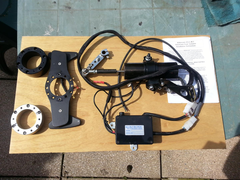

Hello,
Just playing around with the idea of an electric shift on my R1 engine.
My mate is very savy with this sort of stuff so we are looking at making our own system.
Question is sourcing an actuator.
Has anyone tried making their own? Best options for an actuator?
Any info or ideas would be great.
Thanks
Made one for a project on an FSAE car. While we were somewhat limited on time and tooling, we couldn't get it smaller than kliktronic solenoids
available for buttons. The control electronics could be more advanced though, mis-shift detection maybe, flatshift integration etc. We ditched it in
the end as after a lot of testing, humans were faster 
The Klicktronic is about as small as you can go, very heavy for the size, and the "control" box is simply two relays, one for up and one for
down.


Description
Maybe something suitable in the reversible linear solenoid section
?
I warn you that from experience they are not cheap!
quote:
Originally posted by Rich J
Maybe something suitable in the reversible linear solenoid section ?
I warn you that from experience they are not cheap!
Solenoids are unbelievably easy to make - just wind a good few hundred turns of copper wire around a former and it gives a good pull on a soft iron
core.
Google it and you can find some easy sums to work out pulling force , no of turns and current draw.
Cheers!
PS What force do you require and what distance does it have to act over?
[Edited on 4-2-20 by v8kid]
If it's not set up perfectly you'll eventually kill the box
See my avatar...
Closed loop with a sensor on the gearbox barrel is apparently the way forward.
Geartronics website has some info on this.
Pneumatic supposed to be kinder also but arguably more expensive
To an extent this is true. The force applied by a solenoid gets greater the closer it gets to the end position. However the point of control
electronics is to sense this and adjust accordingly and reduce the holding current to zero.
Pneumatics are a constant force but require a reservoir plus a pump depending on the run time.
Fancy programming is the answer which the OP professes to be in possession of.
This could be an excellent project in the making
Cheers
It's an interesting design problem.
Winding a solenoid is easy, making it repeatable, reliable and well packaged is not so easy.
[Edited on 5/2/20 by coyoteboy]
From memory, the worst issue with this was the fact that the required shift force profile is a hump (light at first, then potentially stiff (but not necessarily) and then light again). Humans are very good at identifying the load, the speed and the sounds associated with a shift and using that feedback to control force and clutch timing. A system capable of that is actually quite complex. How to handle a slow shift (box hangs up). How to handle a mis-shift (box doesn't shift at all). How to handle a shift that moves freely without massively over-forcing the shift with the expected higher force etc.
The variable force shouldn't be a problem if there is positional feedback ditto missed shifts. A bit like mapping ignition timing all it needs is
a Arduino and a wiz kid to programme it 
The OP reckons his mate is up to it if I infer the post correctly.
The point about reliability and repeatability is a real concern and applies to any homebrew system, in all probability it would be cheaper and
certainly a lot quicker to buy a new/second hand unit.
Still an interesting project if you are otherwise bored! (but not for me)
Cheers
Thanks for all the comments.
We will start looking for a reversible solenoid.
The image was definitely to use an andrino and do all sorts of tuning and feedback etc.
To get the thing up and running, a push pull cable will be used first and then progress to an electric system.
Just a warning up front, you're going to need a support PCB to go with your arduino for power conditioning and switching hardware, from memory
you're looking at spikes of 50-100A and arduinos are really not happy in automotive conditions without a good amount of effort up front in power
conditioning.
Arduino might not be the ideal option to be honest but it would be a good starting point.
I am wondering if a linear actuator is actually the right way to do this.
we are trying to rotate a shaft,
could you use a standard stepper motor, and some gearing?
quote:
Originally posted by gremlin1234
I am wondering if a linear actuator is actually the right way to do this.
we are trying to rotate a shaft,
could you use a standard stepper motor, and some gearing?
I looked into electric gear shifts, and the possibilities of using rc servos (there's several big/fast servos available with plenty of
torque...80 - 100kg) and with some suitable drivers/software is quite doable, but the suitable servos aren't cheap.
It's a project i will do in the future for my Metro, and whilst i'd need 2 servo's to do my H pattern, it's only software..
100Kg(cm) servo is ~10Nm - that ain't enough to turn the selector on my box without some hefty gearing.
[Edited on 8/2/20 by coyoteboy]
quote:
Originally posted by coyoteboy
100Kg(cm) servo is ~10Nm - that ain't enough to turn the selector on my box without some hefty gearing.
[Edited on 8/2/20 by coyoteboy]